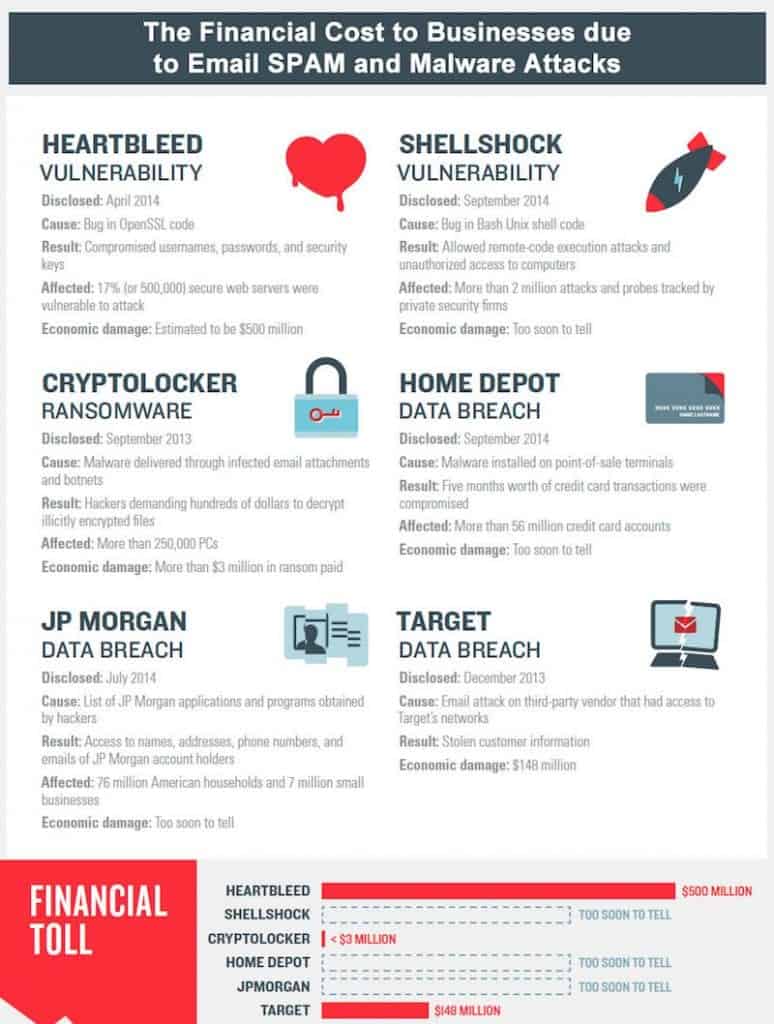Here are some revealing statistics from the Internet security firm Symantec’s July 2014 Intelligence Report: of the billions of emails traveling the information superhighway each day, nearly 63.7% are spam. One out of every 351 emails contains a virus. And 7.9% of all emails contain a malicious URL.
Even as spam filters beef up, more of this devious junk seems to get through. What about that opt-out button at the bottom of every piece of spam I get? Is it smart to respond to the spam you get with “UNSUBSCRIBE” in the subject line? Clicking to opt-out and unsubscribe or responding to a spammer often just confirms to them that you own a legitimate inbox, which can actually result in more spam, not less.
How do these cyberattackers and their villainous emails continue to proliferate?
A Few Recent Deceits Have Come to Our Attention:
- Spammers often choose IP addresses that are nearly identical to real service providers (in August, 150,000 JPMorgan Chase customers received malware-infested messages from what appeared to be a valid domain urging them to click to view a secure message from the bank).
- Spammers place random words in messages to avoid text-based spam filters.
- Spammers create and send junk emails from newly registered domains with no spam history at a rate faster than filters can keep up.
- Spammers have even figured out a way to crack Apple’s iMessage system.
Besides giving up on email altogether, what can you do to fight the nonstop tide of spam? Nothing is foolproof, but here are a few tips:
Five Steps You Can Take to Fight Spam
1) Don’t click on ANY links in ANY unfamiliar emails. Malware is most often delivered through infected attachments like PDFs or MP3 files, while exploit kits and Trojan viruses often wait at the other end of links in spam messages. And if you click on a link in an email, the analytics used by spammers will show you as an active prospect and send you more.
2) Don’t expose your email address—and always check the sender’s address. Is your email address featured prominently at the top of your social media profiles? Spammers love an easy target like that. Either make it private or write it up long (use the word “at” instead of the symbol “@” and spell out “dot com” instead of “.com”). Additionally, always check the actual email address of any message you get from a name you recognize. One common hack is to use a friend or family member’s name as a spam account’s username to trick you into opening it.
3) Don’t reply and don’t unsubscribe. We all wish spammers could feel our rage. But when you respond to a spam email, you tell the dark underbelly of the cyber world that your account is active. The same goes for clicking unsubscribe—all that does is let spammers know you’re real. Add that domain name to your blocked senders list instead of clicking on anything.
4) Flag, flag, flag. If you get a suspicious-looking email from an unfamiliar address, flag it within your mail program, move it to your junk folder, or report it to your email provider. Gmail recently improved its spam capability to block messages with suspicious letter combinations—the more you report emails such as that, the stronger spam filters become.
5) Employ a robust anti-spam service to protect your inbox. CMIT Solutions’ anti-spam software works 24/7 to refine the filters that catch bad messages before they overwhelm the good. A technical support rep for our anti-spam partner reiterated the “flag, flag, flag” message last week in response to a reported spike in worldwide spam: “Our filters immediately begin collecting data to update… the more examples you give us, the better. Updating the filter is related to trends, not instances. One spam message getting through isn’t very helpful; if there are 10 messages, we can look through them to get the commonalities.”
Is an increase in spam wrecking your workday? Are your employees wasting hours every day digging through email trash to find the gold? Have your systems been afflicted by malware, phishing attacks, or email-borne viruses? Call or contact a trusted IT provider like CMIT Solutions today and say goodbye to spam—and hello to dramatically increased productivity.

